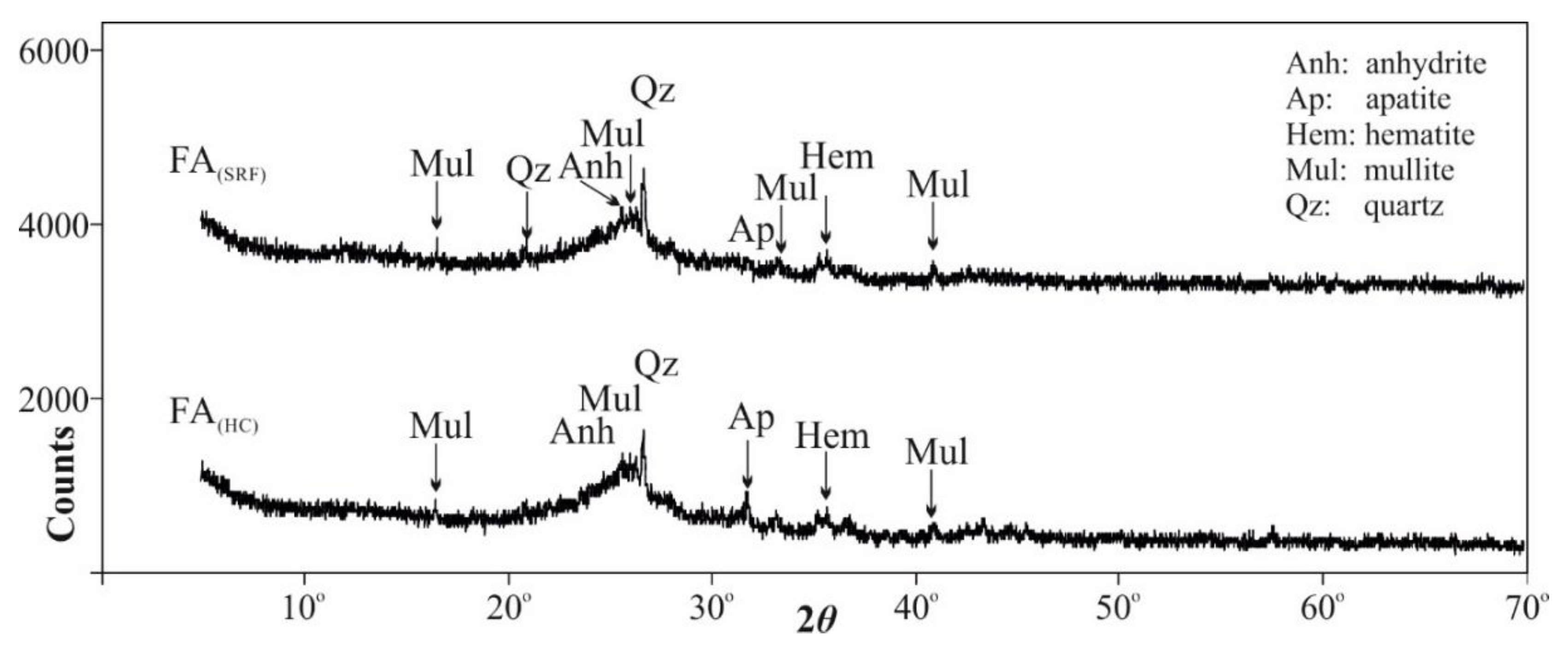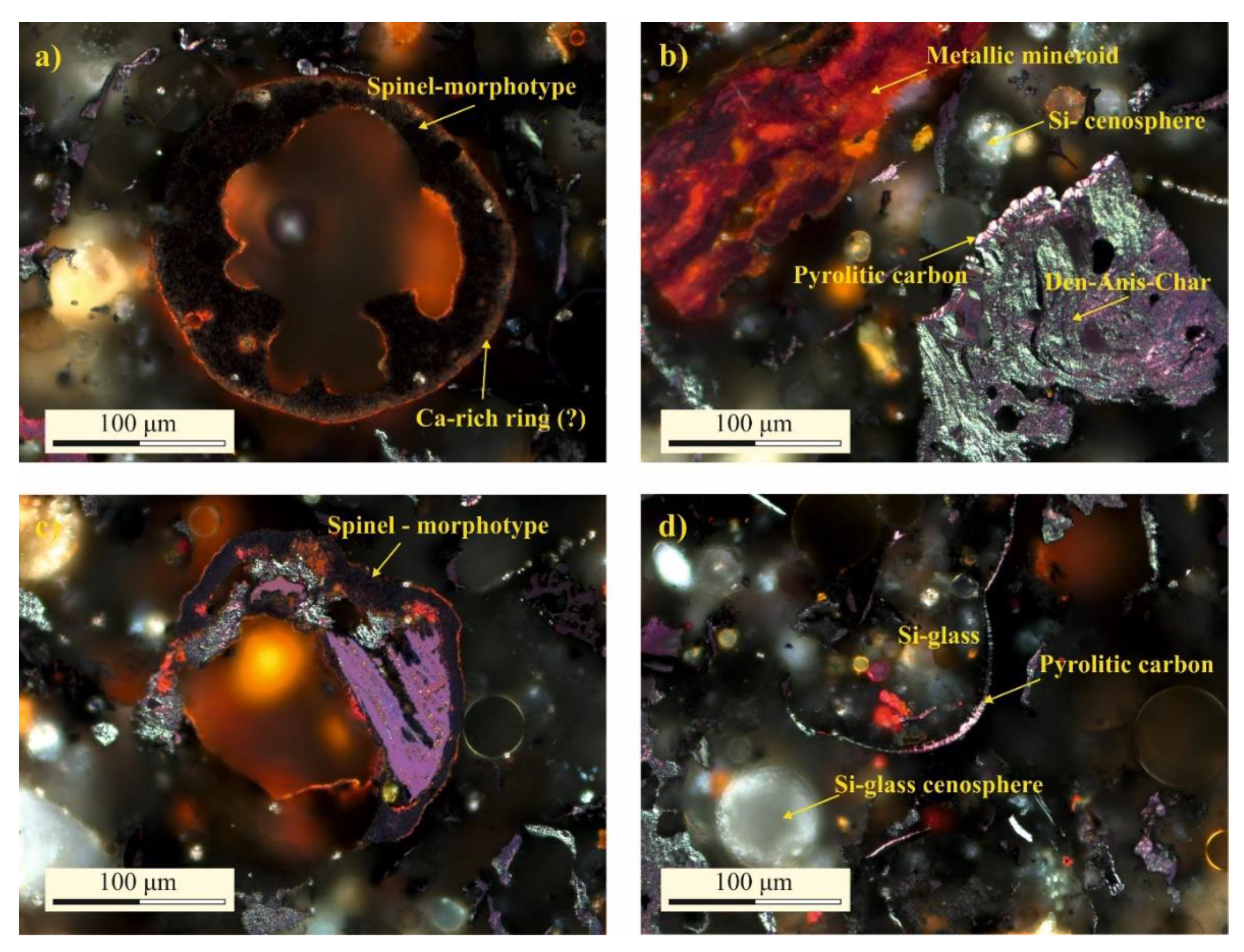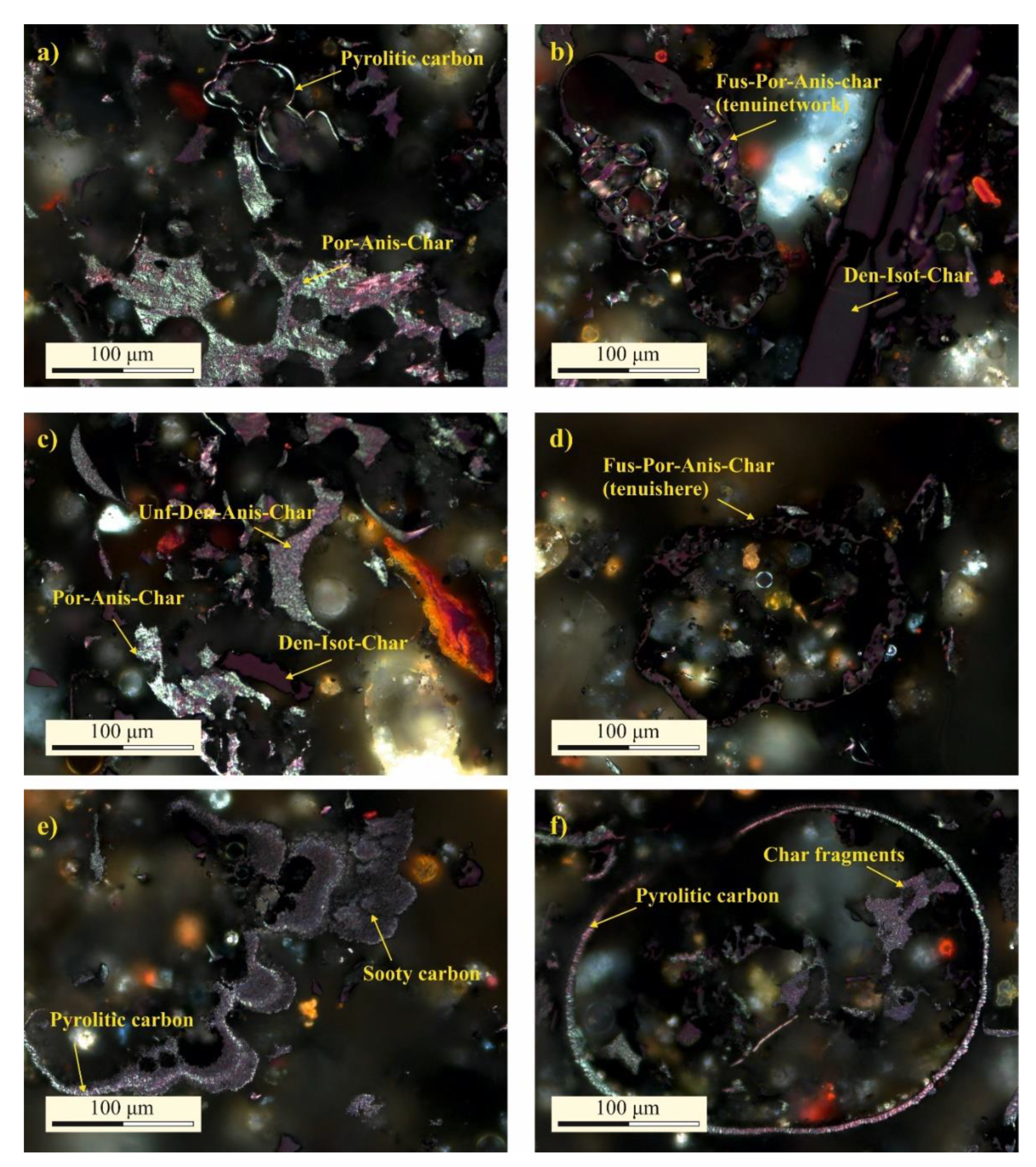Organic Petrographical Features of Fly Ashes Originating from Coal and Coal-SRF Co-Combustion
Abstract
1. Introduction
2. Materials and Methods
3. Results and Discussion
3.1. Inorganic Geochemical and Mineralogical and Features
3.2. Organic Petrographical Featues
4. Conclusions
Author Contributions
Funding
Data Availability Statement
Conflicts of Interest
References
- Hower, J.C. Petrographic examination of coal-combustion fly ash. Int. J. Coal Geol. 2012, 92, 90–97. [Google Scholar] [CrossRef]
- Hower, J.C.; Groppo, J.G.; Graham, U.M.; Ward, C.R.; Kostova, I.J.; Maroto-Valer, M.M.; Dai, S. Coal-derived unburned carbons in fly ash: A review. Int. J. Coal Geol. 2017, 179, 11–27. [Google Scholar] [CrossRef]
- Valentim, B.; Białecka, B.; Gonçalves, P.A.; Guedes, A.; Guimarães, R.; Cruceru, M.; Całus-Moszko, J.; Popescu, L.G.; Predeanu, G.; Santos, A.C. Undifferentiated Inorganics in Coal Fly Ash and Bottom Ash: Calcispheres, Magnesiacalcispheres, and Magnesiaspheres. Minerals 2018, 8, 140. [Google Scholar] [CrossRef]
- Wawer, M. Identification of Technogenic Magnetic Particles and Forms of Occurrence of Potentially Toxic Elements Present in Fly Ashes and Soil. Minerals 2020, 10, 1066. [Google Scholar] [CrossRef]
- Papadakis, V.G. Effect of sly ash on Portland cement systems. Part I: Low-calcium fly ash. Cem. Concr. Res. 1999, 29, 1727–1736. [Google Scholar] [CrossRef]
- Chindaprasirt, P.; Jaturapitakkul, C.; Sinsiri, T. Effect of fly ash fineness on comprehensive strength and pore size of blended cement paste. Cem. Concr. Compos. 2005, 27, 425–428. [Google Scholar] [CrossRef]
- Diaz, E.I.; Allouche, E.N.; Eklund, S. Factors affecting the suitability of fly ash as source material for geopolymers. Fuel 2010, 89, 992–996. [Google Scholar] [CrossRef]
- Longos, A., Jr.; Tigue, A.A.; Dollente, I.J.; Malenab, R.A.; Bernardo-Arugay, I.; Hinode, H.; Kurniawan, W.; Promentilla, M.A. Optimization of the Mix Formulation of Geopolymer Using Nickel-Laterite Mine Waste and Coal Fly Ash. Minerals 2020, 10, 1144. [Google Scholar] [CrossRef]
- Dwivedi, A.; Jain, M.K. Fly ash—Waste management and overview: A review. Recent Res. Sci. Technol. 2014, 6, 30–35. [Google Scholar]
- Juenger, M.C.G.; Siddique, R. Recent advances in understanding the role of supplementary cementitious materials in concrete. Cem. Concr. Res. 2017, 78, 71–80. [Google Scholar] [CrossRef]
- Uliasz-Bocheńczyk, A.; Mokrzycki, E. The potential of FBC fly ashes to reduce CO2 emissions. Sci. Rep. 2020, 10, 9469. [Google Scholar] [CrossRef] [PubMed]
- EIA. Energy Information. Available online: https://www.eia.gov/international/analysis/country/POL (accessed on 15 December 2020).
- Wójcik, M.; Stachowicz, F.; Masłoń, A. The possibility of the application of fly ashes in order to the improvement of sewage sludge dewatering. J. Civ. Eng. Environ. Archit. 2017, 34, 377–393. (In Polish) [Google Scholar] [CrossRef][Green Version]
- Blajer, M.; Stopkowicz, A.; Adamczyk, J.; Cała, M. The preliminary research of the physico-mechanical properties of aggregates based on the colliery shale, supplemented by fly ash. Arch. Min. Sci. 2019, 64, 21–34. [Google Scholar]
- Korniejenko, K.; Halyag, N.P.; Mucsi, G. Fly ash as a raw material for geopolymerisation—Chemical composition and physical properties. IOP Conf. Ser. Mater. Sci. Eng. 2019, 706, 012002. [Google Scholar] [CrossRef]
- Suárez-Ruiz, I.; Ward, C. Coal Combustion. In Applied Coal Petrology, the Role of Petrology in Coal Utilization, 1st ed.; Suárez-Ruiz, I., Crelling, J.C., Eds.; Academic Press: London, UK, 2008. [Google Scholar]
- Ahmaruzzaman, M. A review on the utilization of fly ash. Prog. Energy Combust. Sci. 2010, 36, 327–363. [Google Scholar] [CrossRef]
- Jarosiński, A. Mineral and Chemical Composition of Fly Ashes Deriving from Co-Combustion of Biomass with Coal and Its Application. Inżynieria Miner. J. Pol. Miner. Eng. Soc. 2013, 14, 141–148. [Google Scholar]
- Hower, J.C.; Mastalerz, M. An approach toward a combined scheme for the petrographic classification of fly ash. Energy Fuels 2001, 15, 1319–1321. [Google Scholar] [CrossRef]
- Hower, J.C.; Suárez-Ruiz, I.; Mastalerz, M. An approach toward a combined scheme for the petrographic classification of fly ash: Revision and clarification. Energy Fuels 2005, 19, 653–655. [Google Scholar] [CrossRef]
- Suárez-Ruiz, I.; Valentim, B.; Borrego, A.G.; Bouzinos, A.; Flores, D.; Kalaitzidis, S.; Malinconico, M.L.; Marques, M.; Misz-Kenan, M.; Predeanu, G.; et al. Development of a petrographic classification of fly ash components from coal combustion and co-combustion. (An ICCP Classification System, Fly Ash Working Group—Commission III). Int. J. Coal Geol. 2017, 183, 188–203. [Google Scholar]
- Iacovidou, E.; Hahladakis, J.; Deans, I.; Velis, C.; Purnell, P. Technical properties of biomass and solid recovered fuel (SRF) co-fired with coal: Impact on multi-dimensional resource recovery value. Waste Manag. 2018, 73, 535–545. [Google Scholar] [CrossRef]
- Wasielewski, R.; Wojtaszek, M.; Plis, A. Investigation of fly ash from co-combustion of alternative fuel (SRF) with hard coal in a stoker boiler. Arch. Environ. Prot. 2020, 46, 58–67. [Google Scholar]
- ISO (International Organization for Standardization) 7404-2. Methods for The Petrographic Analysis of Coals–Part 2: Methods of Preparing Coal Samples; International Organization for Standardization: Geneva, Switzerland, 2009; 12p. [Google Scholar]
- ASTM C618-19. Standard Specification for Coal Fly Ash and Raw or Calcined Natural Pozzolan for Use in Concrete; ASTM International: West Conshohocken, PA, USA, 2019. [Google Scholar]
- Williams, R.P.; van Riessen, A. Determination of the reactive component of fly ashes for geopolymer production using XRF and XRD. Fuel 2010, 89, 2683–3692. [Google Scholar] [CrossRef]
- Lester, E.; Alvarez, D.; Borrego, A.G.; Valentim, B.; Flores, D.; Clift, D.A.; Rosenberg, P.; Kwiecinska, B.; Barranco, R.; Petersen, H.I.; et al. The procedure used to develop a coal char classification—Commission III Combustion Working Group of the International Committee for Coal and Organic Petrology. Int. J. Coal Geol. 2010, 81, 333–342. [Google Scholar] [CrossRef]
- Wasielewski, R.; Głód, K.; Telenga-Kopyczyńska, J. Energy and emission aspects of co-combustion solid recovered fuel with coal in a stoker boiler. E3S Web Conf. 2018, 28, 01037. [Google Scholar] [CrossRef]
- Lester, E.; Cloke, M.; Allen, M. Char characterization using image analysis techniques. Energy Fuels 1996, 10, 696–703. [Google Scholar] [CrossRef]
- Jarosz-Krzemińska, E.; Poluszyńska, J. Repurposing fly ash derived from biomass combustion in fluidized bed boilers in large energy power plants as a mineral soil amendment. Energies 2020, 13, 4805. [Google Scholar] [CrossRef]
- Ewa Szatyłowicza, E.; Krasowska, M. Assessment of heavy metals leaching from fly ashes as an indicator of their agricultural use. Desalin. Water Treat. 2020, 199, 288–296. [Google Scholar] [CrossRef]
- Karapanagioti, H.; James, G.; Sabatini, D.; Kalaitzidis, S.; Christanis, K.; Gustafsson, O. Evaluating Charcoal presence in sediments and its effect on Phenanthrene sorption. Water Air Soil Pollut. Focus 2004, 4, 359–373. [Google Scholar] [CrossRef]
- Cornelissen, G.; Breedveld, G.D.; Kalaitzidis, S.; Christanis, K.; Kibsgaard, A.; Oen, A. Strong sorption of native PAH’s to pyrogenic and unburned carbonaceous geosorbents in sediments. Environ. Sci. Technol. 2006, 40, 1197–1203. [Google Scholar] [CrossRef]





| Fuel | Moisture | Ash | VM | C | S |
|---|---|---|---|---|---|
| wt.%-ar 1 | wt.%-db 2 | wt.%-daf 3 | wt.%-db 2 | wt.%-db 2 | |
| Hard coal | 5.3 | 23.9 | 32.9 | 65.5 | 0.52 |
| Blend of coal and 10% SRF | 7.2 | 20.9 | 45.5 | 64.9 | 0.44 |
| Parameter | FA(HC) | FA(SRF) | FA(HC) | FA(SRF) | |
|---|---|---|---|---|---|
| UC-R (wt.% db) 1 | 29.73 | 33.38 | |||
| Oxides wt.% | Trace Elements (mg/kg) | ||||
| SiO2 | 45.14 | 44.91 | As | 42 | 25 |
| TiO2 | 1.16 | 1.50 | Cd | 3 | 5 |
| Al2O3 | 24.26 | 21.25 | Co | 66 | 118 |
| Fe2O3 | 9.53 | 8.95 | Cr | 148 | 143 |
| MgO | 3.71 | 4.31 | Cu | 321 | 356 |
| CaO | 6.76 | 9.07 | Mn | 697 | 560 |
| Na2O | 1.76 | 2.46 | Ni | 205 | 215 |
| K2O | 2.84 | 2.32 | Pb | 154 | 128 |
| P2O5 | 1.72 | 1.29 | Sb | 37 | 169 |
| SrO | 0.29 | 0.20 | V | 371 | 353 |
| Hg | 3 | 3 | |||
| BaO | 0.45 | 0.35 | |||
| SO3 | 1.27 | 2.03 | |||
| Sample | Quartz | Mullite | Anhydrite | Hematite | Apatite | Anatase |
|---|---|---|---|---|---|---|
| SiO2 | Al6Si2O13 | CaSO4 | Fe2O3 | Ca5(PO4)3 | TiO2 | |
| FA(HC) | 50 | 28 | 10 | 10 | 2 | <1 |
| FA(SRF) | 51 | 27 | 12 | 8 | 2 | <1 |
| Samples | Nature (vol.%-wr 1) | Optical Character (vol.%-mmf) | ||||
| Inorganic | Organic | Fused | Unfused | |||
| Metallic | Non-Metallic | Total | ||||
| FA(HC) | 2.2 | 43.0 | 45.2 | 54.8 | 88.7 | 11.3 |
| FA(SRF) | 2.7 | 27.5 | 30.2 | 69.8 | 82.1 | 17.9 |
| Samples | Structure/Morphology (vol.%-mmf) | Optical Texture (vol.%-mmf) | Origin (vol.%-wr) | |||
| Dense | Porous | Isotropic | Anisotropic | Coal | Other Fuels | |
| FA(HC) | 65.9 | 34.1 | 13.9 | 86.1 | 54.8 | - |
| FA(SRF) | 60.7 | 39.3 | 28.7 | 71.3 | 50.2 | 19.6 |
Publisher’s Note: MDPI stays neutral with regard to jurisdictional claims in published maps and institutional affiliations. |
© 2021 by the authors. Licensee MDPI, Basel, Switzerland. This article is an open access article distributed under the terms and conditions of the Creative Commons Attribution (CC BY) license (http://creativecommons.org/licenses/by/4.0/).
Share and Cite
Wojtaszek, M.; Wasielewski, R.; Kalaitzidis, S. Organic Petrographical Features of Fly Ashes Originating from Coal and Coal-SRF Co-Combustion. Minerals 2021, 11, 128. https://doi.org/10.3390/min11020128
Wojtaszek M, Wasielewski R, Kalaitzidis S. Organic Petrographical Features of Fly Ashes Originating from Coal and Coal-SRF Co-Combustion. Minerals. 2021; 11(2):128. https://doi.org/10.3390/min11020128
Chicago/Turabian StyleWojtaszek, Małgorzata, Ryszard Wasielewski, and Stavros Kalaitzidis. 2021. "Organic Petrographical Features of Fly Ashes Originating from Coal and Coal-SRF Co-Combustion" Minerals 11, no. 2: 128. https://doi.org/10.3390/min11020128
APA StyleWojtaszek, M., Wasielewski, R., & Kalaitzidis, S. (2021). Organic Petrographical Features of Fly Ashes Originating from Coal and Coal-SRF Co-Combustion. Minerals, 11(2), 128. https://doi.org/10.3390/min11020128







